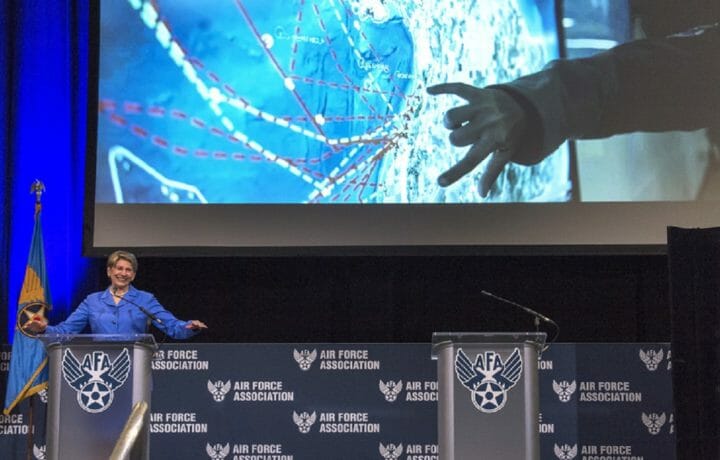On Wednesday, Secretary of the Air Force Barbara Barrett and U.S. Space Force Chief of Space Operations, Gen. John “Jay” Raymond took part in a webinar hosted by the Colorado Springs-based Space Foundation. The online presentation, titled “America’s Space Force: Building the Future Today,” shared information that had been slated to be presented at the now-rescheduled Space Symposium.
It featured a discussion with Barrett and Raymond, who sat six feet apart – with Barrett joking that the “space between us is not the space we’re going to talking about today.” The two addressed the role that Space Force will play as the sixth branch of the U.S. military.
This included addressing potential threats from Russia. Raymond noted Russia had moved a satellite that had the characteristics of a weapons system to close proximity with a U.S satellite. Barrett confirmed that aggressive and war-like actions are already being made by America’s space competitors; while Raymond added that the American public needs a better understanding of how space today fuels the American way of life, but has the potential to fuel the American way of war.
The webinar was also used as a platform to debut its first recruiting video, which featured the powerful tagline, “maybe your purpose on this planet isn’t on this planet.”
Recruitment hasn’t really been an issue for the Space Force, which was officially “launched” as the newest branch of the military after the White House signed into law the National Defense Authorization Act last December. Barrett noted, “There’s been an avalanche of applicants.” In addition, last month it was announced that U.S. Air Force active duty members could volunteer to officially transfer to the new service beginning this month.
Addressing the Fictional Space Force
Raymond also showed that he had a bit of a sense of humor when he was asked about the upcoming Netflix comedy series Space Force, which was created by and stars comedian Steve Carrell of The Office.
“The one piece of advice I’d give to Steve Carell is to get a haircut,” said Raymond, who sports a clean shaven head, “You’re looking a little too shaggy if you want to play the Space Force chief.”
Raymond added that he would have preferred to have been played by a fellow bald man such as Bruce Willis, but said that Carrel is a “great actor, and I love his shows. We’re looking forward to it.”
Space X-37B Mission
This week the Department of the Air Force Rapid Capabilities Office, in partnership with the U.S. Space Force, announced that it has scheduled the launch of its sixth mission of its secret X-37B Orbital Test Vehicle (OTV-6). The launch will be on May 16 at Cape Canaveral Air Force Station, FL.
“In today’s age of electrons, space systems track storms, locate stranded motorists, timestamp credit card transactions, and monitor treaty compliance,” explained Barrett. “Demonstrating the department’s innovation, this X-37B mission will host more experiments than any prior missions. This launch also demonstrates the department’s collaboration that pushes the boundaries for reusable space systems.”
The X-37B is a small, unmanned OTV that resembles NASA’s Space Shuttle but is only a fraction of the size. Its last mission was completed in October of last year when it returned to Earth after 780 days in orbit.
This is the first mission to use a service module, which is an attachment at the aft of the vehicle, to host experiments.
“The X-37B team continues to exemplify the kind of lean, agile and forward-leaning technology development we need as a nation in the space domain,” said Raymond. “Each launch represents a significant milestone and advancement in terms of how we build, test, and deploy space capabilities in a rapid and responsive manner.”
It remains a Department of the Air Force asset, but the Space Force is responsible for the launch, on-orbit operations and landing.
“This launch is a prime example of integrated operations between the Air Force, Space Force, and government-industry partnerships,” said Air Force Chief of Staff Gen. David Goldfein. “The X-37B continues to break barriers in advancing reusable space vehicle technologies and is a significant investment in advancing future space capabilities.”




